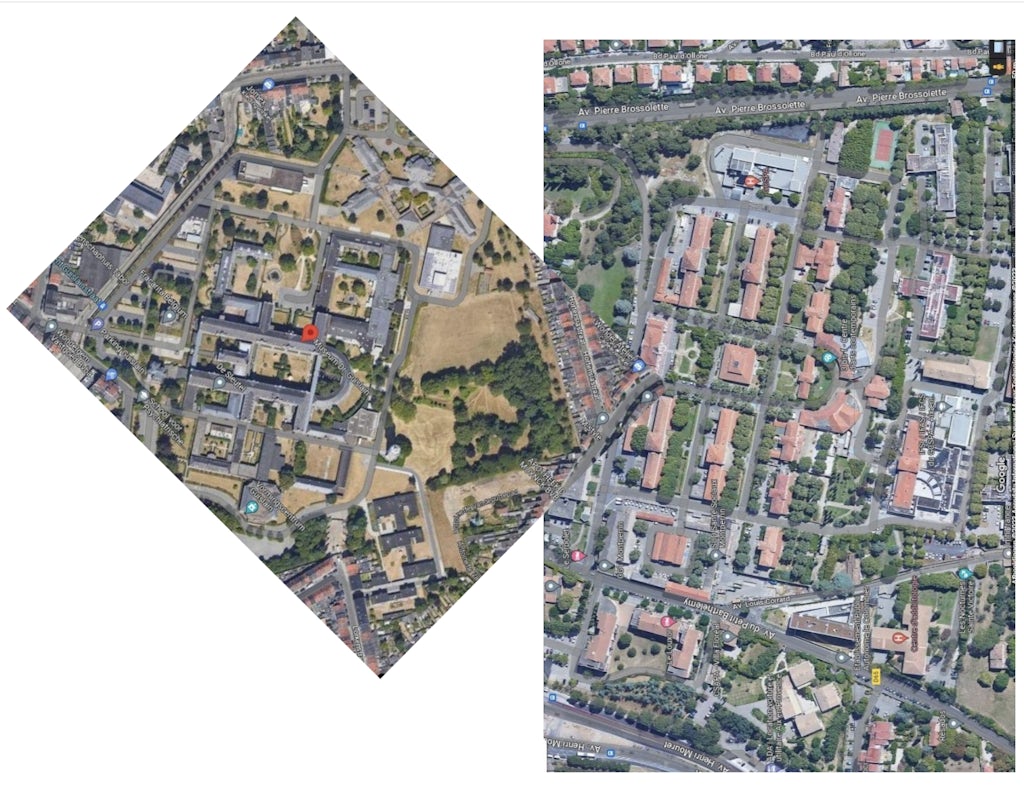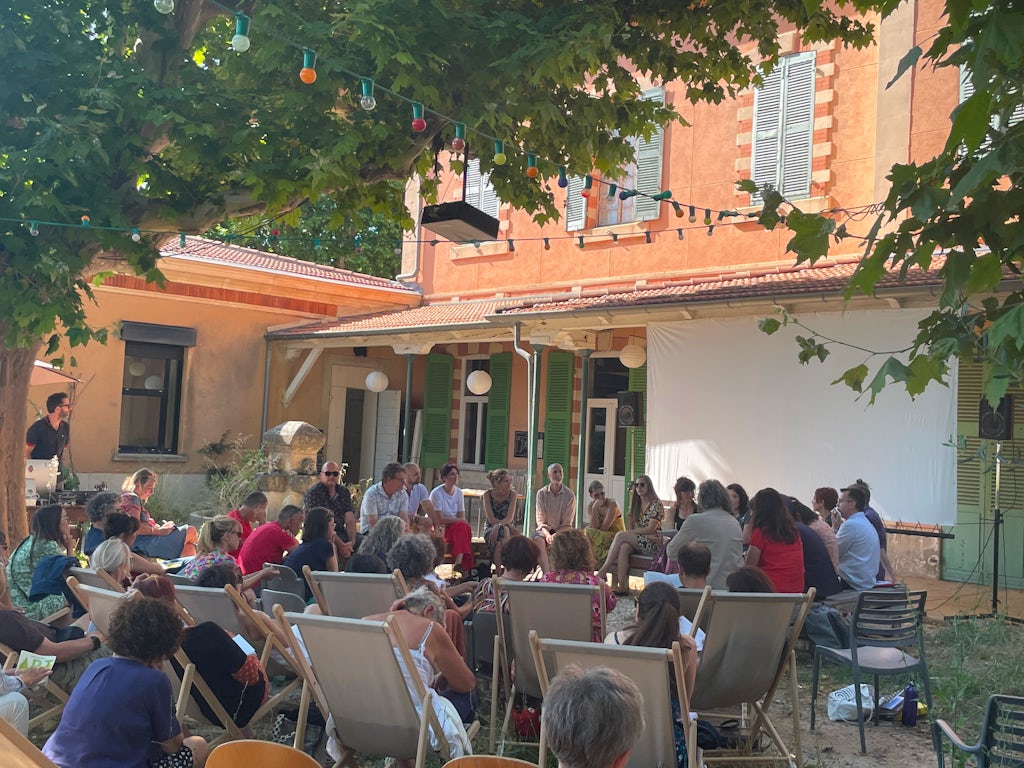Art of Caring, the Care of Art
At the invitation of Flanders Arts Institute, Petra Van Dyck participated in the international meeting Premières rencontres Art, Soin, Citoyenneté (24/06/2023) in Aix-en-Provence on the link between care, art and citizenship.
Petra Van Dyck is a psychologist and psychoanalyst who has a great affinity with art and artists. She collaborated on Veridiana Zurita’s Don’t Eat The Microphone project and Anna Rispoli’s Tempus Fugit, among others.
The day was organised by 3 bis f, a venue for contemporary art within the walls of Montperrin psychiatric hospital. 3 bis f welcomes artists in residence to work with patients.
Below you can read some excerpts from Petra’s report. You can download the full text (in Dutch) outlining her experiences and reflections at the bottom of this page.
Therapeutic architecture
What immediately strikes Petra when she arrives at 3 bis f are the building’s similarities to the architecture of the Museum and Psychiatric Centre Dr Guislain in Ghent. According to Guislain and his contemporaries, this kind of architecture serves ‘moral treatment’.
For Van Dyck, the architecture of these 19th-century buildings is in line with the ‘humanistic re-education principles’ of the time. Patients are accommodated and cared for in bright pavilions with beautifully landscaped enclosed courtyards, but at the same time they are thus detached and confined on the outskirts of the city, in a fenced-in asylum where a re-education programme is used in the form of therapy.

The U-shape of the building aimed to isolate the patients with the most severe problems at the back of the ’roundness of the U’, away from the outside world. As they were ‘socialised’, they moved more towards the entrance, until they were ‘released’ back into the community.
3 bis f is located in the former isolation rooms of the psychiatric hospital. The arched structures are constructed so that you can supervise and discipline prisoners or psychiatric patients as much as possible with as little effort and/or personnel as possible. So the emphasis is on monitoring, controlling, disciplining, studying, comparing and improving.
Perhaps 3 bis f just settled in this wing of the building to open up the closedness of the isolation cells to the residential pavilions on the one hand, and psychiatry to the outside world on the other?
About 3 bis F: how can we enrich each other through exchanges of (vulnerable) experiences?
Forty years ago, 3 bis f was set up on the initiative of hospital staff and local (visual) artists. 3 bis f challenges two artists with different backgrounds and practices to experiment in residence for 11 months. The residency consists of a back-and-forth between the solitary research in the studio and the collective sharing of the experiment in sessions with patients and in the form of an exhibition.
3 bis f thus puts experimentation and research at the centre on the one hand and aims to provide a space for encounters, confrontations and questions between artists, patients, art professionals, healthcare staff, social workers and the public on the other.
Petra wonders whether the space and time offered to an artist by 3 bis f is less and less to be found in the arts sector and seems rather to have been pushed to this ‘fringe’. Perhaps the time and space offered to artists by 3 bis f even contrasts with patients in ‘residency’, who in Belgium are not allowed to spend more than six months in admission.
In practice, for a patient, that often means just the time to get around to re-entering the social format economically. There is no time or patience to recover fundamentally. This often results in a revolving door effect: out of admission and back in a little later. In this way, the illusion of efficiency seems fed but at the expense of ‘continuity time’.
“Artists and people with mental health issues share a lot in terms of the obstacles they face, their position in the community, being perceived as disruptive, living/working in residency …”
Jasmine Lebert, director of 3 bis f, explains during a workshop that the strength of the soutien mutuel between art and care lies in trying to get to know and understand each other’s territory as well as possible: how can we enrich each other through exchanges of (vulnerable) experiences?
This speaks to Petra’s own experience both with artists and in her therapeutic practice where most of the ‘patients’ are artists: artists and people with mental health problems, she says, share a lot in terms of the obstacles they face, their position in the community, being perceived as disruptive, living/working in residency …

Should patients and experts by experience have been more involved?
The day on art, care and citizenship included several workshops, a roundtable discussion, a film and an exhibition. For Petra, this condensed programme was at odds with the intention, which was to give time and space to artists in residence and create encounters with as heterogeneous a group as possible. The busy programme left little time to make contacts and exchange experiences. Even about how the interaction between artists, citizens and patients could be concrete, it often remained vague and superficial.
How could patients have been more involved in the workshops, the roundtable discussion, organising food and drinks, or touring the exhibition, garden, or other workshops?
For Petra, it felt like a missed opportunity to do more with artistic work or interventions during the programme. Could patients, citizens, visitors, experts by experience with care have been more involved? Could a concrete exchange based on an artistic practice have implied more responsibility and mutual involvement of the attendees? Didn’t the form and manner of organisation keep both visitor, organiser or patient too much in their roles?
3 bis f is valuable project that addresses the mindset of allowing people, organisations and practices to meet. In doing so, it is an art to remain alert to the tension between form and content, and to let caring artistic practices set something in motion. This takes time and a persistent critical eye. Although 3 bis f has already had a long and fascinating journey in this and they seem to understand the obstacles, for Petra they only partially succeeded in making this way of thinking also ‘come through’ in their approach to this kind of networking day.
For Petra, it seems as if we also lack courage in both care and the arts to take risks to question a course of action, to take up something together with care. She asks the question: how can we unite even better, support each other to face obstacles together and arrive at something new, staying alert and critical with a lot of love for difference?
Read more?
- Check the programme of the event
- Read more about the various initiatives around art and care that were discussed during the day (in Dutch)
- Read Petra Van Dyck’s in-depth personal report (in Dutch)


